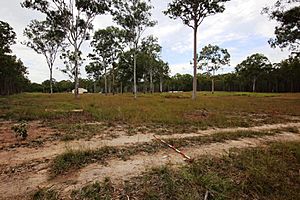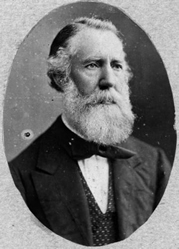Pacific Islander Hospital and Cemetery site facts for kids
Quick facts for kids Pacific Islander Hospital and Cemetery site |
|
|---|---|

Pacific Islander Hospital and Cemetery site from the north-west, 2017
|
|
| Location | corner of Bluebell Road East and Gernich Road, Tinana, Fraser Coast Region, Queensland, Australia |
| Design period | 1870s-1890s Late 19th century |
| Built | 1883–1888,1883–1888,1883 |
| Official name: Pacific Islander Hospital and Cemetery site, Tinana; South Sea Islander Hospital and Cemetery site, Tinana; Pacific Islander Hospital, Maryborough site | |
| Type | state heritage |
| Designated | 27 October 2017 |
| Reference no. | 650053 |
| Type | Archaeological: Archaeological potential; Archaeological: Artefact scatter; Burial ground: Cemetery-private; Health and care services: Hospital-other |
| Theme | Providing health and welfare services: Providing health services |
| Lua error in Module:Location_map at line 420: attempt to index field 'wikibase' (a nil value). | |
The Pacific Islander Hospital and Cemetery site is a special historical place in Tinana, Australia. It used to be a hospital and a private cemetery. It was built between 1883 and 1888. This site is also known as the South Sea Islander Hospital and Cemetery site. It was added to the Queensland Heritage Register in 2017 because it is very important to Queensland's history.
Contents
Why Was This Hospital Built?
The Pacific Islander Hospital and Cemetery site is near Maryborough. It was a hospital for South Sea Islanders, who were also called Pacific Islanders or Polynesians. This hospital was one of only four built for these workers.
It opened in 1883 and closed in 1888. The hospital was built because many South Sea Islanders were getting sick and dying. They were brought to Queensland to work, especially in the sugar industry.
This site helps us understand the lives and challenges faced by these workers. It also shows how the Queensland Government tried to help them. The cemetery part of the site is especially important. It can teach us more about the lives of these workers.
The Start of Maryborough and Sugar Farming
Maryborough began in 1847. It was a port town that helped settlers in the area. By 1859, it became an official port. Many people came to Queensland through Maryborough. The discovery of gold nearby in 1867 also helped Maryborough grow.
Sugar cane farming started around Maryborough in the late 1860s. Sugar cane needs a warm climate. Areas like Maryborough, Mackay, and Bundaberg were perfect for it.
Why South Sea Islanders Came to Queensland
There weren't enough workers in Queensland at the time. People thought that Europeans couldn't handle the hard work in the hot climate. So, plantation owners looked for workers from other countries.
South Sea Islanders were brought to Queensland as workers starting in 1863. They signed contracts to work for about three years. Most came from islands in Melanesia, like Vanuatu and the Solomon Islands.
These workers were very important for the sugar industry. They did most of the field work. Many returned home after their contracts ended.
Working Conditions and Early Concerns
The first South Sea Islanders arrived in Maryborough in 1867. They worked for low wages, much less than European workers.
Soon, people worried about how these workers were treated. There were reports of kidnapping, called blackbirding. The Polynesian Labourer Act of 1868 was created to control how workers were hired. It said that a government agent had to be on each recruiting ship. Workers had to sign contracts and get a minimum wage.
Despite the new laws, concerns about working conditions and health continued. Inspectors were appointed to check on the Islanders.
In 1876, Richard Bingham Sheridan, an inspector in Maryborough, reported bad living conditions. He said that medical care for Islanders was often ignored. He believed some plantation owners didn't care if workers died. This was because they would save money on return travel and wages.
An investigation was held, but it didn't lead to better laws right away. The death rate among South Sea Islanders remained very high. For example, in 1879, the death rate in Maryborough was 7.4% for Islanders. This was much higher than for European men of the same age.
The Need for Central Hospitals
Doctors Wray and Thomson investigated the high death rates in 1880. They found that poor food, long hours, dirty water, and a lack of care for the sick were the main reasons.
They strongly suggested building "Central Polynesian Hospitals" in each area. These hospitals would be run by qualified doctors. The cost would be covered by a fee paid by employers for each Islander worker.
The Pacific Island Labourers Act of 1880 made medical care for Islanders required. It also allowed for the building of these central hospitals. However, it took three more years for the first hospitals to be built.
The Hospital's Operation
Two central hospitals opened in 1883. One was in Mackay, and the other was at Tinana, near Maryborough. The Queensland Government, along with planters, helped pay for them.
The Tinana hospital was built to care for 50 patients. It had two wards, a dispensary (where medicines were prepared), and a kitchen. There was also a house for the doctor.
Challenges and Changes at the Hospital
Dr. Charles H Clarkson was the first doctor at the Tinana hospital. He quickly asked for improvements. He wanted the surrounding trees cleared and fences built. He also asked for more rooms for patients with contagious diseases.
Clarkson also noted that the hospital needed more water. He suggested connecting it to the Tinana waterworks. He also requested a washing shed, stables, and a "dead house" (morgue).
He also pointed out the need for a cemetery nearby. The main Maryborough cemetery was too far away. A "Polynesian Cemetery" reserve was later created in the northeast corner of the hospital site.
In December 1883, Clarkson hired staff, including wardsmen and South Sea Islander wardsmen. They helped with tasks like cutting firewood and making changes to the hospital.
Illnesses like dysentery and malaria were common. In March 1884, Clarkson reported many admissions and a high death rate.
Water supply continued to be a problem. The hospital committee asked for water to be connected from Tinana. They noted that the existing waterhole was dirty. Water pipes were laid, but the pressure was low.
Problems with Management and Closure
In 1886, the hospital's management committee resigned. They were unhappy with the doctor's spending and the high death rate. The number of South Sea Islander deaths in the Maryborough area had increased.
Dr. Joseph, the resident surgeon, faced an investigation. He was accused of misusing hospital resources and staff. He was dismissed in April 1886.
Around this time, the number of South Sea Islanders in the Maryborough area began to decrease. This was due to falling sugar prices and new laws. The Pacific Islanders Act of 1885 aimed to stop the recruitment of South Sea Islander workers by 1890.
By 1887, the cost of running the Pacific Islander Hospitals was very high. It was suggested that they should all close. The Maryborough and Mackay hospitals closed on December 31, 1888.
After the central hospitals closed, South Sea Islanders were cared for in separate wards at general hospitals. Part of the Tinana hospital building was moved to the Maryborough General Hospital to become a "Polynesians" ward.
What Remains Today?
A survey plan from 1891 shows the hospital building and doctor's residence. The Polynesian Cemetery Reserve was identified as a specific area.
In 1892, the remaining buildings were inspected for sale. Some parts of the hospital had already been removed. The doctor's residence was moved and rebuilt as a Police Station in Tinana.
A total of 363 patients died at the Pacific Islander Hospital in Maryborough between 1883 and 1888. Before these hospitals, Islanders were often buried on plantations. The Maryborough Cemetery has a small section for South Sea Islanders. But it's likely many from the hospital were buried in the nearby Polynesian Cemetery Reserve.
After 1901, new Australian laws ended the South Sea Islander labour trade. Many Islanders were sent back to their home countries. Some were allowed to stay in Australia.
Today, the former hospital and cemetery site has changed over time. A house was built on the cemetery reserve by 1994.
Looking for Clues: Archaeological Survey
In 2017, an archaeological survey was done at the former hospital site. Even though the site has been disturbed, some clues were found. These included concrete slabs that were once chimney bases for the hospital buildings.
Small pieces of ceramic, glass, bone, brick, and clay pipe were also found. Some stone tools and mussel shells were found near a dam. These might be from before the hospital was built.
The cemetery site has high archaeological potential. Future investigations, like using ground-penetrating radar, could help find out more about the burials. This could tell us about burial practices, death rates, and the lives of South Sea Islanders.
Remembering the Past
The Kanaka Memorial in Maryborough's Mary River Parklands remembers the hard work and sacrifices of the South Sea Islander workers.
The hospital and cemetery site was added to the Queensland Heritage Register in 2017. This was done to highlight the important history of South Sea Islanders and their connection to this place.
Images for kids








